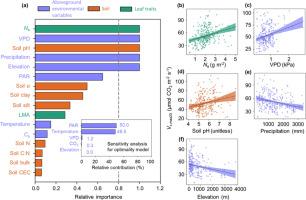全球光合能力由酶动力学和生态环境驱动因素共同决定
IF 6.3
3区 综合性期刊
Q1 Multidisciplinary
引用次数: 0
摘要
准确理解全球光合能力(即最大RuBisCO羧化率,Vc, max)变异对于改善陆地生态系统光合代谢和碳循环随气候变化的模拟至关重要,但目前仍缺乏全面的理解和评估。本文假设Vc, max由温度相关酶动力学(捕获瞬时生态生理反应)和活化RuBisCO(以Vc为索引,max在25℃标准化,Vc, max25)两个因素决定,并编制了一个全面的全球数据集(来自428个站点的n = 7339个观测值)用于假设检验。光合作用数据来源于叶片气体交换测量,使用便携式气体交换系统。我们发现,考虑这两个因素的半经验统计模型解释了78%的全局Vc,最大变异性,其次是55%的酶动力学单独解释。该统计模型在预测全局Vc最大变异性方面优于当前的理论最优性模型(67%),主要是由于其对全局Vc max25变异性的表征较差(3%)。此外,我们证明,除了气候变量,地下资源对光合机制的限制直接构成了Vc的生物地理结构,max25是改进全球Vc最大变异性理论模型的关键缺失机制。这些发现提高了对全球Vc、max变率的机理认识,并为气候变化下陆地光合作用和碳循环的基准过程模型提供了重要依据。本文章由计算机程序翻译,如有差异,请以英文原文为准。

Global photosynthetic capacity jointly determined by enzyme kinetics and eco-evo-environmental drivers
Accurate understanding of global photosynthetic capacity (i.e. maximum RuBisCO carboxylation rate, Vc, max) variability is critical for improved simulations of terrestrial ecosystem photosynthesis metabolisms and carbon cycles with climate change, but a holistic understanding and assessment remains lacking. Here we hypothesized that Vc, max was dictated by both factors of temperature-associated enzyme kinetics (capturing instantaneous ecophysiological responses) and the amount of activated RuBisCO (indexed by Vc, max standardized at 25 ℃, Vc, max25), and compiled a comprehensive global dataset (n = 7339 observations from 428 sites) for hypothesis testing. The photosynthesis data were derived from leaf gas exchange measurements using portable gas exchange systems. We found that a semi-empirical statistical model considering both factors explained 78% of global Vc, max variability, followed by 55% explained by enzyme kinetics alone. This statistical model outperformed the current theoretical optimality model for predicting global Vc, max variability (67%), primarily due to its poor characterization on global Vc, max25 variability (3%). Further, we demonstrated that, in addition to climatic variables, belowground resource constraint on photosynthetic machinery built-up that directly structures the biogeography of Vc, max25 was a key missing mechanism for improving the theoretical modelling of global Vc, max variability. These findings improve the mechanistic understanding of global Vc, max variability and provide an important basis to benchmark process-based models of terrestrial photosynthesis and carbon cycling under climate change.
求助全文
通过发布文献求助,成功后即可免费获取论文全文。
去求助
来源期刊

Fundamental Research
Multidisciplinary-Multidisciplinary
CiteScore
4.00
自引率
1.60%
发文量
294
审稿时长
79 days
期刊介绍:
 求助内容:
求助内容: 应助结果提醒方式:
应助结果提醒方式:


